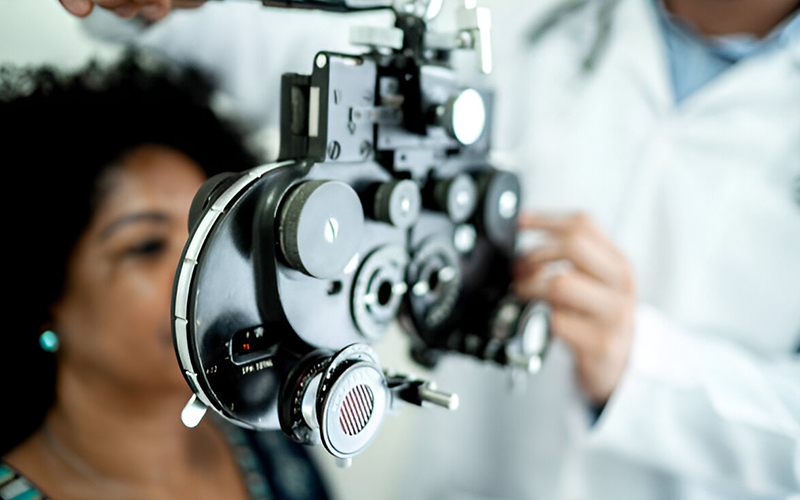
What Does D Mean In Eye Prescription?
When you receive your eye prescription, you might encounter letters and numbers that seem confusing. One commonly seen character is the letter “D.” But what does it mean? This article explains the significance of “D” and how it relates to your vision. Understanding this detail helps you determine the strength of your lenses and how they enhance your sight.

Eye Prescription Basics
An eye prescription consists of several components that dictate how your glasses or contact lenses correct your vision. One important value is the sphere (SPH), which indicates the lens power needed for nearsightedness or farsightedness. A negative SPH means nearsightedness, while a positive value points to farsightedness. If you have astigmatism, your prescription will also include cylinder (CYL) and axis values to account for the irregular shape of your cornea.
These components guide eye care professionals in determining the right lenses for your vision correction. The lens power is measured in diopters (D), the unit that describes how much correction your eyes need. You may also notice abbreviations like OD for your right eye and OS for your left eye. Additionally, some prescriptions include an “ADD” value, which represents additional magnification needed for reading or close-up tasks, commonly found in bifocal or progressive lenses.
Here’s a table breaking down the common abbreviations you might see:
|
Abbreviation |
Meaning |
Description |
|
OD |
Oculus Dexter (Right Eye) |
Prescription for the right eye |
|
OS |
Oculus Sinister (Left Eye) |
Prescription for the left eye |
|
SPH |
Sphere |
Indicates nearsightedness or farsightedness |
|
CYL |
Cylinder |
Measures astigmatism (irregular cornea curvature) |
|
AXIS |
Axis |
Shows the orientation of astigmatism |
|
ADD |
Addition |
Extra magnification for close-up vision (bifocals/progressives) |
Accurate eye prescriptions are essential for ensuring clear vision. Incorrect lens power can lead to blurry sight and eye strain, so understanding these numbers is key to optimizing your visual experience.
Decoding the ‘D’ in Your Eye Prescription
In an eye prescription, the letter ‘D’ refers to diopters, which measure the lens power required to correct your vision. This value helps indicate how much adjustment is necessary for vision issues such as nearsightedness (indicated by a negative sphere value) or farsightedness (indicated by a positive sphere value). The higher the diopter value, the stronger the lenses required to correct your vision.
Understanding the role of ‘D’ allows you to make informed decisions when choosing your glasses or contact lenses. It also highlights the importance of having the correct diopter value for optimal vision correction. Incorrect diopter values can result in discomfort, such as blurry or distorted vision, and may affect daily tasks like reading or driving.
How Diopters Relate to Your Prescription
The letter ‘D’ in your prescription specifies the amount of correction needed to improve your vision. For example, if your prescription states -2.00 D, it means that lenses need to be adjusted to help you see distant objects more clearly. The diopter number reflects the strength of the lenses, with higher values representing greater visual impairment.
Here’s an example of what a typical prescription might look like:
|
Eye |
SPH (Sphere) |
CYL (Cylinder) |
AXIS |
ADD (Additional Power) |
|
OD |
-2.00 |
-0.75 |
180 |
+1.50 |
|
OS |
-1.50 |
-0.50 |
160 |
+1.50 |
Astigmatism, another common vision issue, is indicated by different values on your prescription. It involves a curvature issue with the cornea, which affects how light is focused on your retina. The diopter value for astigmatism is accompanied by an axis number, which determines the orientation of the curvature.
Importance of Numbers in Eye Prescriptions

Each number in your prescription has a specific meaning. For example, the sphere (SPH) value measures lens power, while the cylinder (CYL) value measures astigmatism. The axis number shows the angle of astigmatism. Together, these numbers provide a complete picture of your vision needs and allow your eye care professional to craft the most effective lenses for you.
Additionally, pupillary distance (PD) is often included in your prescription to ensure proper lens alignment in your glasses, which is crucial for effective vision correction.
Types of Lenses Based on Your Prescription
Single Vision Lenses
Single vision lenses provide correction for either near or distance vision, using one lens power. These lenses are simple and effective for those with straightforward vision correction needs, such as mild nearsightedness or farsightedness.
Bifocal and Multifocal Lenses
Bifocal and multifocal lenses correct both near and far vision by incorporating multiple lens powers. Bifocals have two distinct areas of correction, while multifocals (like progressive lenses) offer a smoother transition between different focal points. These lenses are often recommended for individuals who need help seeing at various distances due to age-related conditions like presbyopia.
How to Interpret Your Eye Prescription?
Reading your eye prescription involves understanding terms like sphere, cylinder, axis, and diopters. These values help define how your lenses will correct your vision. For example, a strong negative sphere value indicates significant nearsightedness, while a positive value points to farsightedness. The cylinder and axis values provide more detail about astigmatism, and the diopter values indicate the strength of the lenses required.
By understanding your prescription, you can ensure that your lenses are properly tailored to your needs, preventing issues like blurry vision or discomfort.
Regular Eye Exams and Prescription Changes
Your eye prescription may change over time due to factors such as aging, lifestyle habits, or changes in eye health. Regular eye exams are essential for keeping your prescription up to date and ensuring that your lenses continue to correct your vision effectively.
Consult an Eye Care Professional
Whenever you receive an eye prescription, it’s important to consult with an eye care professional to fully understand what the values mean. They can explain how each component of your prescription affects your vision and help you choose the best lenses for your specific needs.
Conclusion
Understanding the details of your eye prescription, especially the significance of ‘D’ for diopters, empowers you to make informed decisions about your vision care. Each value in the prescription plays a crucial role in ensuring that your lenses are tailored to your specific needs, whether you’re correcting nearsightedness, farsightedness, or astigmatism. Regular eye exams and proper lens selection are essential to maintaining clear and comfortable vision as your eyesight changes over time. By being proactive and consulting with an eye care professional, you can ensure your eyes remain healthy and your vision stays sharp. Check for more information at Optics Town, we provide the most professional wholesale optical frames online.




